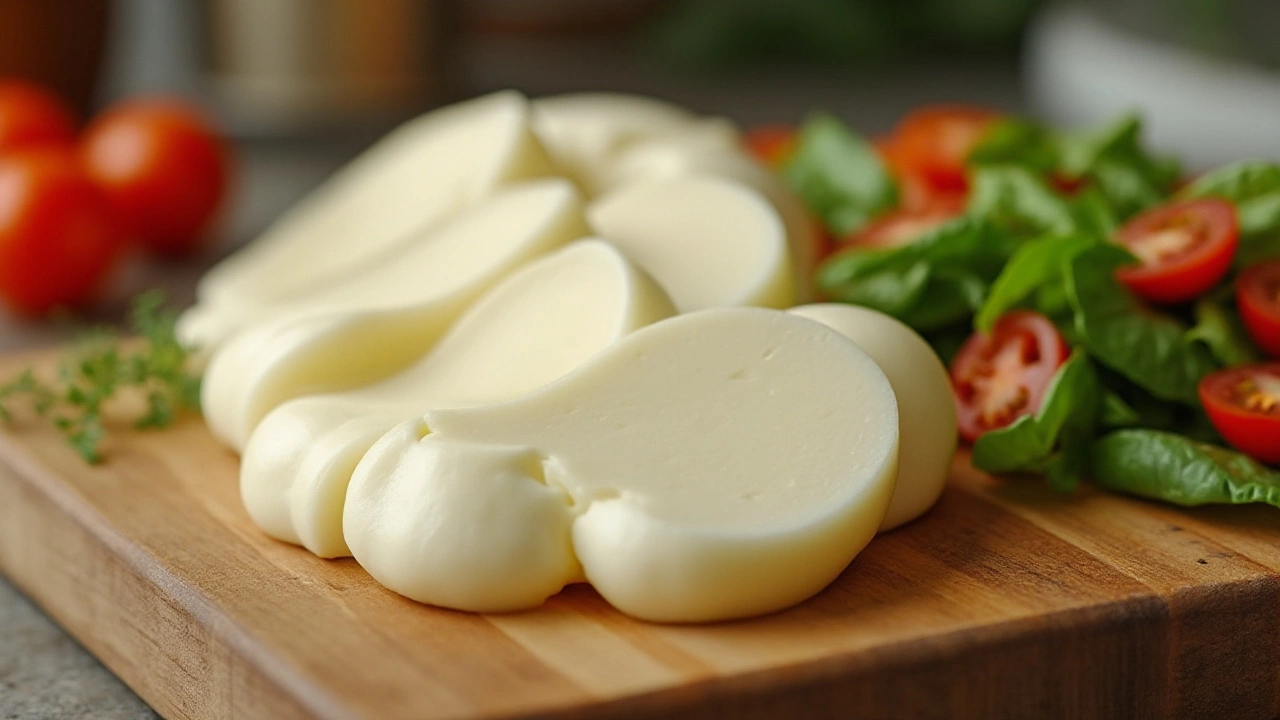
Cheese is a beloved ingredient across the globe, bringing joy to pasta dishes, sandwiches, and everything in between. But when it comes to choosing the right cheese for your diet, understanding the fat content becomes essential. Today, we're diving into the world of mozzarella and Emmental cheeses to uncover their distinct characteristics and how they might fit into your dietary goals.
Mozzarella, with its smooth and stretchy texture, is often praised for melting beautifully onto pizzas and into lasagna layers. Each bite offers a gentle flavor, but how much fat slips between its strands? Emmental, on the other hand, warms the palate with its nutty notes and famous holes, often seen adorning charcuterie boards and nestled in fondue pots. But does its delightful taste come with a heftier fat profile?
Join us as we navigate these storied cheeses, exploring their nutritional makeup and learning delicious ways to enjoy them without sacrificing a balanced lifestyle. Whether you're a cheese connoisseur or simply curious about your next snack choice, there's something to uncover in the layers of mozzarella and Emmental.
- Understanding Cheese Fat Content
- Mozzarella: Texture and Nutrition
- Emmental: Flavor and Fatty Acids
- Health Implications of Cheese Fat
- Tips for Balanced Cheese Consumption
- Pairing Cheesewith Dishes
Understanding Cheese Fat Content
When diving into the world of cheeses, one aspect that often raises curiosity is the fat content. This interest doesn't stem just from a health perspective, but also because fat lends cheese its distinctive texture and flavor profile. Take, for instance, our contenders: mozzarella cheese and Emmental. Cheese fat content is primarily influenced by the type of milk used, whether it's whole, semi-skimmed, or skim. Whole milk typically results in a higher fat cheese, which in return contributes to creamier textures and richer aromas. This is one of the reasons why cheeses, such as Brie or Camembert, are celebrated for their decadent mouthfeel.
Fat in cheese isn't just about tasting good; it serves an essential role in the cheese's structure. Cheeses like Emmental, known for its iconic holes and nutty flavors, rely on fat to support its texture and flavor complexity. Emmental's unique characteristics, including its distinctive eyes, come from the formation of carbon dioxide gas as the lactic bacteria in the cheese mature. The fat helps to stabilize these formations, influencing both appearance and taste. On the other hand, mozzarella cheese, often made from the milk of water buffaloes in Italy, boasts a delicate, subtle flavor, with less fat contributing to a lighter texture that's desirable for melting on pizzas and lasagnas.
To understand fat content more scientifically, it’s crucial to look at the percentage of fat in dry matter. This standard allows comparison regardless of the moisture content in cheese. Mozzarella tends to have a dry matter fat content of about 20-25%, whereas Emmental can exceed 30%. These percentages aren't just numbers; they influence everything from taste to how the cheese behaves when cooked. For example, high-fat cheeses generally melt more smoothly, creating that luscious, stretchy effect people love in dishes like pizza.
The American Dairy Association notes that incorporating cheese into a balanced diet can offer health benefits, providing proteins, calcium, and essential vitamins. Interestingly, a scientific study published by the National Library of Medicine described cheeses as containing unique fatty acids that may help reduce the risk of cardiovascular disease. Yet, moderation is key, particularly given the saturated fats that accompany these benefits. For those monitoring their fat intake, selecting lower-fat versions of mozzarella or opting for portion control with Emmental can be viable strategies.
The demand for low-fat cheese alternatives is rising, with manufacturers continually innovating to meet health-conscious customers' needs. A table of comparison might help illustrate:
| Cheese Type | Approximate Fat Content (per 100g) |
|---|---|
| Mozzarella | 22g |
| Emmental | 28g |
Through such a lens, cheese lovers can understand the critical role fat plays, balancing between indulgence and healthfulness. Whether enjoyed in moderation or as part of a diet strategy, understanding these elements can elevate one’s cheese appreciation, making every tasting a more informed experience.
Mozzarella: Texture and Nutrition
Mozzarella cheese is not just a staple for many classic dishes, it's a sensory delight, marked by its soft texture that effortlessly transforms into a gooey marvel when melted. This stretchiness is due to its high moisture content, a result of being made from cow's or buffalo's milk which is formed into curds, then kneaded and pulled to achieve that distinctive consistency. Mozzarella fans appreciate its comforting creaminess, perfect for toppings on pizzas, layering in lasagnas, or simply enjoyed with slices of fresh tomato and basil. The cheese's delicate flavor allows it to blend seamlessly into various culinary creations without overpowering other ingredients. But while it dance upon our taste buds, mozzarella's nutritional profile remains a topic of intrigue, especially for those attentive to their dietary intake.
When it comes to nutrition, mozzarella stands on its own by being relatively lower in fat compared to many other cheeses. A 100g serving of mozzarella contains about 22g of fat, with 13g of saturated fat. This positions it as a moderately light cheese, making it a preferable choice for those monitoring fat consumption. In terms of protein, mozzarella doesn't lag behind, offering around 22g per 100g serving, a valuable benefit for muscle building and satiety. These figures may vary slightly depending on the type or brand, but the cheese consistently supports a well-rounded diet considering its inclusion of essential minerals like calcium, required for healthy bones, and phosphorous. And let's not forget the moderate amounts of soluble vitamins like A, which aid in vision and skin health, adding to the reasons mozzarella graces our tables so often.
"From the Italian countryside, mozzarella has captured hearts worldwide not only through its flavors but through its generous nutritional offerings," notes renowned nutritionist Dr. Maria Rossi. "Its balance of macronutrients makes it a favored cheese for those reaching towards healthier eating habits."
Yet, choosing mozzarella over other cheeses isn't just about counting calories or fats. Its lower sodium content, compared to processed or aged cheeses, also makes it a go-to for those watching their salt intake. Whether part of a Caprese salad or a topping on Neapolitan pizza, mozzarella can be a more conscious choice. When considering its versatility in the kitchen, the cheese provides numerous opportunities for innovative meals without compromising nutritional goals. Here is a handy breakdown:
| Nutrient | Amount per 100g |
|---|---|
| Calories | 280 |
| Fat | 22g |
| Protein | 22g |
| Calcium | 505mg |
In the contemporary kitchen, mozzarella's adaptable nature is embraced by chefs and home cooks alike. It transforms simple dinners into delightful experiences, bringing warmth to sandwiches or depth to casseroles. Given its nutritional benefits coupled with its culinary versatility, it's evident why mozzarella frequently finds itself as both a nutritious and favorite choice on the menu. The delightful layers of this beloved cheese continue to inspire taste and nutrition alike, creating a culinary romance we all can savor.

Emmental: Flavor and Fatty Acids
Emmental cheese, commonly mistaken as Swiss cheese due to its signature holes, is a tantalizing journey into the world of flavors. Its nutty, slightly tangy taste owes a great deal to the specific type of bacterial cultures used during fermentation. These cultures are responsible for the cheese's unique texture and appearance. Originating from the Emmental Valley in Switzerland, this semi-hard cheese is aged for several months, allowing the development of its complex flavors. As it ages, the emons estimate that it contains around 27 grams of fat per 100 grams, making it a richer option compared to many other cheeses. Emmental's high-fat content provides a creamy base for dishes like fondues or elegant cheese plates. Emmental cheese's fat content contributes a substantial amount of energy.
The fatty acids present in Emmental can be beneficial, particularly the presence of conjugated linoleic acid (CLA), which has been studied for its potential health benefits. Some research suggests that CLA can help in maintaining body composition, promoting heart health, and even reducing inflammation. The intricate balance of saturated and unsaturated fats gives Emmental a distinctive mouthfeel. There's a growing appreciation for cheeses like Emmental, where the fat profile is not merely a nutritional detail but a key player in the flavor experience. Cheese enthusiasts value the harmony between taste and texture, relishing the slight oiliness that comes from the natural fats. It's no wonder Emmental consistently finds itself as a favorite in cheese competitions globally.
With its robust flavor, Emmental stands as a crucial ingredient in various traditional recipes. Its rich fat content means it melts beautifully, adding depth and lusciousness to dishes. When paired with a glass of crisp white wine or a hearty ale, Emmental cheese brings forth a symphony of flavors that many find hard to resist. Presentation matters, too; those distinctive holes are not just for show but form during the fermentation as gases from bacteria get trapped. This visual and taste delight reminds us of how intertwined Emmental is with both visual and gastronomic cultures worldwide. The turophiles, the cheese lovers, will advocate for Emmental's place at the table, with its fatty profiles embraced hotly amidst culinary discussions.
For those conscious of fat intake, enjoying Emmental in moderation is a wise approach. The beauty of this cheese lies in its optimal balance—it can be grated over salads, melted into sauces, or savored on its own with a side of crusty bread. An old Swiss proverb encapsulates this: "A meal without cheese is like a beautiful woman with only one eye." Moderation ensures you revel in its luxurious texture and rich flavor, without overwhelming your daily nutritional goals. Embrace Emmental's cheesy delights without the guilt by pairing it with fruits, especially grapes or figs, which cut through its richness and complement its nutty nuances perfectly.
Health Implications of Cheese Fat
Cheese is a dietary staple celebrated for its rich flavors and textures, yet often scrutinized for its fat content. The fat in cheese can play a significant role in our health, making it a topic worthy of exploration. Both mozzarella cheese and emmental cheese, despite having different fat compositions, offer essential nutrients that can benefit our health when consumed mindfully. The fat in cheese is predominantly saturated, which has been discussed in the context of heart health for decades. While diet guidelines traditionally advised limiting saturated fat intake, recent studies suggest saturated fats may not be as harmful as once thought when part of a balanced diet.
Current research sheds light on the value of cheese in moderation. For instance, cheese is a good source of conjugated linoleic acid (CLA), a type of fat that might have health benefits, such as improving weight management and reducing the risk of heart disease. Mozzarella, being lower in fat compared to Emmental, offers a lighter alternative for those monitoring their fat intake without compromising nutrition. However, both cheeses provide a spectrum of vitamins and minerals, including calcium and vitamin B12, which are crucial for maintaining bone health and proper neurological function. A balanced approach to cheese consumption recognizes its place alongside other protein sources, ensuring that fat intake does not exceed recommended daily values.
"Consuming cheese in varied forms, paired wisely with fruits, vegetables, and whole grains, integrates essential nutrients in diets, often leading to more satisfying and satiating meals," suggests a recently published article in the Journal of Nutrition. This perspective urges a shift in how we perceive cheese's fatty content, encouraging dietary harmonization rather than elimination. Importantly, understanding the levels of sodium in cheese also helps in managing blood pressure and reducing cardiovascular risk. Moderating cheese intake by measuring portions and selecting lower-sodium varieties can complement an overall healthy lifestyle. Table data from a 2023 dietary study highlights an interesting contrast:
| Cheese Type | Average Fat Content (%) | Calcium (mg per 100g) |
|---|---|---|
| Mozzarella | 17% | 505 |
| Emmental | 28% | 870 |
These numbers reflect how distinct types of cheese offer unique contributions to a nutritious diet, emphasizing the importance of personalized nutrition choices. Whether opting for lower-fat mozzarella or indulging in a slice of Emmental, it's worthwhile to enjoy these cheeses as part of a varied dietary palette, balancing fatty delights with other wholesome foods. By doing so, we not only savor their flavors but also embrace the broader spectrum of nutritional benefits they bring to the table, harmonizing taste with health objectives.

Tips for Balanced Cheese Consumption
Indulging in the creamy delight of mozzarella cheese or the nutty charm of Emmental cheese, while keeping a watchful eye on health, need not be mutually exclusive endeavors. It's all about making informed choices and applying moderation to your dietary habits. Cheese, in general, is a nutritious food, packed with protein, calcium, and other vital nutrients. However, its fat content often raises eyebrows among the health-conscious. To balance your love for cheese with your health goals, consider the serving size as your first point of moderation. Often, a serving of cheese, about one ounce, is roughly the size of a pair of dice. Keeping it to this modest portion can help keep calorie and fat intake in check.
When planning your meals, think of cheese as an accent rather than the main event. Incorporating cheese into a diet filled with varied textures and colors from fruits, vegetables, and whole grains will not only keep your plate enticing but also ensure a spectrum of nutrients. For instance, sprinkling a handful of shredded mozzarella over a fresh salad, or adding slices of Emmental to a multigrain sandwich, can introduce flavor without overwhelming the dish. And remember, cheese can play a significant role in a well-rounded diet, thanks to its calcium content, which supports bone health. According to the European Food Information Council, a small portion of cheese can provide up to 20% of one's daily calcium needs, making it a beneficial addition to your diet when consumed responsibly.
Pairing cheese with the right foods can enhance its nutritional profile. The combination of cheese with fibrous vegetables can aid digestion and offset some of the cheese's saturated fat content. Consider a robust kale salad punctuated with crumbles of mozzarella, or roasted Brussels sprouts tossed with shavings of Emmental. This method not only balances flavors but also adds to a sense of fullness, helping you feel satisfied with less cheese. It's also important to consider the role of physical activity in balancing the dietary intake of high-fat foods. Regular exercise boosts overall metabolism, ensuring that slight indulgences do not accumulate. As Maya Angelou once wisely said,
"Do the best you can until you know better. Then when you know better, do better." Learning and applying these tips can transform how you think about cheese in your everyday meals.
For cheese lovers interested in watching their salt intake, opt for low-sodium versions of your favorite cheeses. Fortunately, both mozzarella and Emmental are available in reduced-sodium variants. These options provide the same flavors without the added burden of excessive salt, which is known to have adverse effects on blood pressure. When buying cheese, always check the nutritional label for information on both sodium and fat content. Including diverse cheese options in a balanced meal can enrich both flavor and nutrition while maintaining health priorities. Explore moderate consumption of these cheeses within a broader, balanced dietary framework, and relish in the wide world of culinary possibilities they afford.
Pairing Cheese with Dishes
When it comes to pairing cheese with dishes, understanding the unique flavors and textures of each cheese can transform a simple meal into a culinary masterpiece. With its mild, milky flavor, mozzarella cheese serves as a humble yet versatile complement to many recipes. A fresh caprese salad gets a refreshing lift from mozzarella's creamy texture, enhancing the juicy burst of ripe tomatoes and the aromatic punch of fresh basil. This trio, drizzled with a balsamic glaze, makes for a classic Italian antipasto that's hard to resist.
On pizza, mozzarella's melting capability creates that distinguished cheese stretch that we all adore, marrying instantly with a tomato sauce's tanginess and whatever toppings your heart desires, from earthy mushrooms to spicy pepperoni. Its subtle flavor allows the other ingredients to shine, yet there's no denying its presence in the gooey, mouthwatering bites. Lasagna also benefits from the addition of mozzarella, where the cheese melds with a hearty marinara sauce and layers of perfectly cooked pasta, bringing comfort to every forkful.
On the opposite end of the cheese spectrum is the bold and distinctive flavor of Emmental cheese. This nutty wonder, indigenous to Switzerland, often surprises newcomers with its slight sweetness and buttery undertones. Emmental is a standout partner for dishes that thrive on robust flavors. A classic Swiss fondue, for instance, relies heavily on Emmental paired with Gruyère to create that creamy, delicious pot of melted magic. Imagine dipping crusty bread into this, each piece emerging with a luscious coating of melted cheese that holds hints of wine and garlic.
Emmental also shines in sandwiches, especially those that benefit from toasty, warm ingredients. Think of a Croque-Monsieur, the quintessential French bistro sandwich where Emmental melts alongside ham under a broiled topping of béchamel sauce. The cheese adds the perfect amount of richness and complexity, creating a comforting yet refined dish. Similarly, in a Reuben sandwich, Emmental provides the ideal backdrop to corned beef, sauerkraut, and Russian dressing, harmonizing the sandwich's layers with its creamy meltability.
"Cheese is the story of milk preserved with the power of time and skill," says Molly McDonough, renowned cheese expert. "Choosing the right cheese can make the simplest dish feel like a luxurious indulgence."
Cheese pairing doesn't end at salads and sandwiches. Just as wine connoisseurs select vinos based on food pairings, the world of cheese offers a plethora of opportunities when thoughtfully combined with different foods. Consider incorporating Emmental into a creamy risotto, where its gentle sweetness complements the earthy tones of wild mushrooms. For mozzarella, try adding it to a summery bruschetta, where its delicate flavor complements fresh diced tomatoes, a hint of garlic, and the bright zing of lemon zest.




